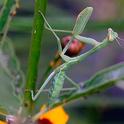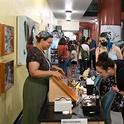Pests, Diseases, Weeds & Pesticides
"What kind of bug is eating my tree (or my plants)?" is the most frequently asked question we get in the Cooperative Extension Office. The resource we use to find the answer is Pest Notes on the University of California Integrated Pest Management (IPM) website. Pest Notes have pictures and descriptions to make comparisons. They tell what damage to look for and what the solutions are.
"What kind of weed is invading my garden?" is another question we are often asked. Again, we find the answer in Pest Notes because weeds are pests, too. There are pictures and descriptions to help identify and manage the problem. There is also a Weed Photo Gallery on the IPM website.
"How do I get rid of an annoying deer (squirrel, skunk, ground hog, gopher, etc.)? Are there deer-resistant plants?" Pest Notes have the answers again! They describe the problem and how to solve it.
Insect control will be necessary most years during some part of the growing season. An all-purpose vegetable spray or dust may be the simplest insect control treatment.
Cultivation is mainly for weed control. The soil should not be allowed to bake around the base of the plants. Hand hoeing is the safest weed control method. Herbicides used in commercial farming are difficult to apply at the recommended rate to small areas. Before using any herbicide, inspect the label for crops that may be safely treated. Herbicide residues may interfere with germination of seeds planted for the next crop season.
Bug Blog
-

Let Us Prey
So here's this female praying mantis, Stagmomantis limbata, camouflaged on a narrow-leaf milkweed, Asclepias fasciculari, in a Vacaville garden. If she thinks she's going to ambush a monarch, she has another think coming. No monarchs in the...
-

Moths and Butterflies: What Are the Differences?
What are the differences between moths and butterflies? That was a key question asked at the Bohart Museum of Entomology's annual Moth Night, held both indoors and outdoors on the UC Davis campus on Saturday, July 20. Doctoral student Iris...
